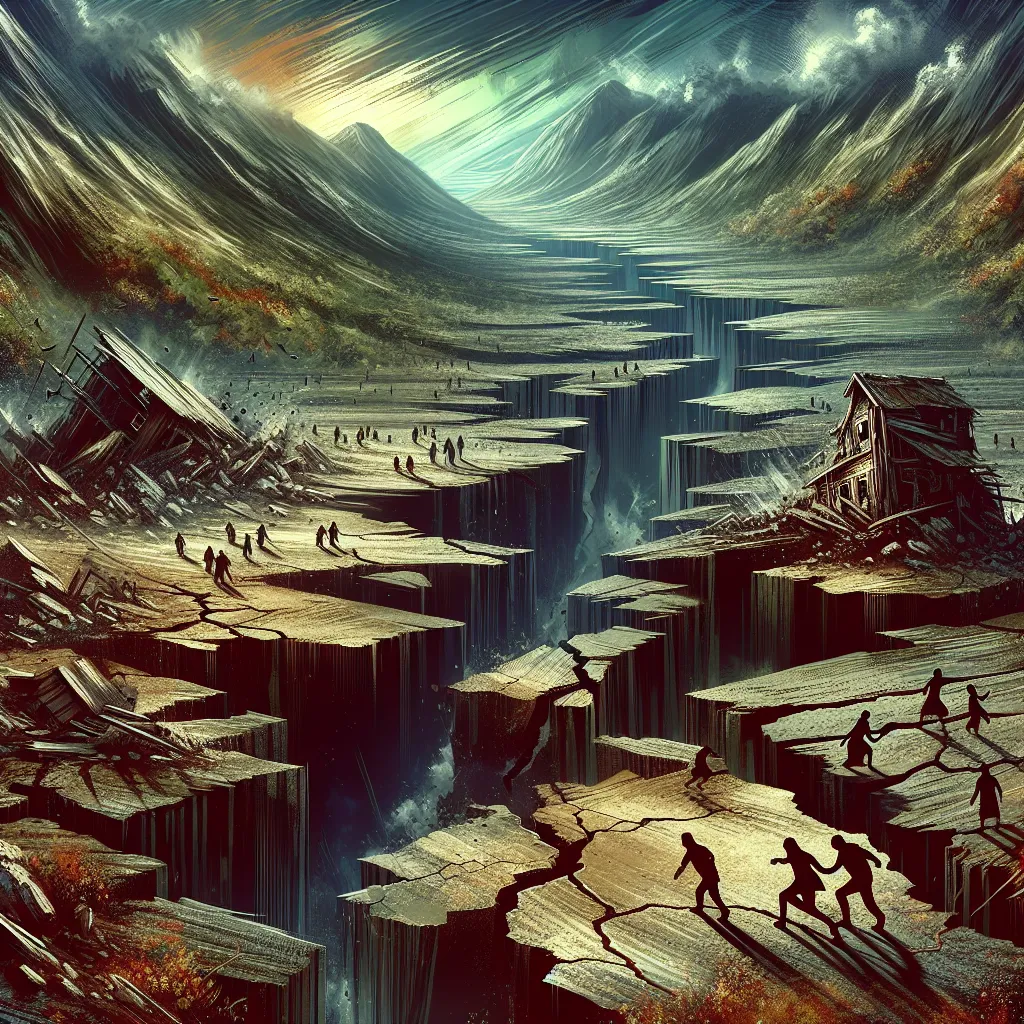Which countries are most prone to earthquakes?

- Where on Earth do earthquakes occur most frequently?
- How to prepare for an earthquake and what to do during one?
It is no secret that certain countries experience earthquakes much more frequently than others. So, what are these places on Earth?
In this material, we will examine the countries where the likelihood of earthquakes is highest, and we will also discuss how to behave if you find yourself in the affected area of this natural phenomenon.
Content:
- Where do earthquakes occur most frequently?
- Top 10 countries prone to earthquakes
- Japan
- Indonesia
- China
- Philippines
- Iran
- Turkey
- Peru
- U.S.
- Italy
- Mexico
- New Zealand
- Less seismically active regions
- Preparing your home for a possible earthquake
- What to do if an earthquake occurs?
- Actions after an earthquake
- Answers to frequently asked questions
Where do earthquakes occur most frequently?
Earthquakes occur for a variety of reasons, including tectonic processes and volcanic activity, which can cause significant changes in the Earth's crust. Although no corner of the planet is completely safe from these phenomena, there are certain areas where the risk of their occurrence is significantly higher. These include:
- Pacific Ring of Fire.This zone is located along the boundary of the Pacific Ocean, where over 81% of the most powerful earthquakes on our planet are recorded. These seismic events occur due to shifts and fractures that arise between tectonic plates.
- Alpine seismic area.It covers regions such as Java and Sumatra, stretching across the Himalayas, the Mediterranean Sea, and the Atlantic Ocean.
- Mid-Atlantic Ridge.This is the boundary where two tectonic plates diverge. Although most of the ridge is hidden underwater, Iceland, which is located right above it, is famous for its high seismic activity.
Top 10 countries with high seismic activity:
Japan
Among the countries with the highest seismic activity, Japan, located within the Pacific Ocean, ranks first. More than 1,500 earthquakes with a magnitude of 4 and above are recorded here annually. Due to such activity, the country has established one of the most extensive seismic networks in the world. The Great East Japan Earthquake, which occurred on March 11, 2011, had a magnitude of 9.0 and triggered a devastating tsunami that led to a terrible disaster at the Fukushima nuclear power plant. Japan also regularly faces volcanic activity, as it is situated on the Ring of Fire.
Indonesia
Every year, Indonesia suffers from earthquakes with a magnitude of over 6.0. For example, the Great Earthquake that occurred on December 26, 2004, in Sumatra and the Andaman Islands triggered one of the deadliest tsunamis in history. As a result of this catastrophe in the Indian Ocean, around 230,000 people lost their lives, making Indonesia one of the countries with the highest casualties. In 2018, the country experienced nine earthquakes with a magnitude greater than 6.0, claiming thousands of lives. To minimize the impact of natural disasters, Indonesia has implemented an early warning system for earthquakes called Inatews, which uses a network of seismometers and buoys for immediate response to threats.
China
China is also among the countries where earthquakes cause significant damage. In 2008, a magnitude 7.9 earthquake struck Sichuan province, claiming over 87,000 lives. In response to such tragic events, a series of strict building regulations were introduced in the country aimed at increasing the seismic resistance of buildings. For example, the famous "Bird's Nest" stadium in Beijing was designed with potential strong earthquakes in mind.
Philippines
The Philippines is also among the countries that experience a high degree of seismic activity. Due to the mountainous terrain, earthquakes often lead to devastating landslides. In light of the constant natural disasters, local residents strive to build sturdy structures that are adapted to seismic threats.
Iran
Iran is located at the intersection of several tectonic plates and faults. One of the most devastating seismic disasters in the country occurred in Gilan province in 1990, claiming more than 40,000 lives.
Turkey
Turkey is prone to frequent earthquakes due to its geographical position, being located near several major fault lines. The country sits between the Eurasian, African, and Arabian plates, which leads to constant tremors of varying intensity.
Peru
Peru is located in the center of the Ring of Fire and regularly experiences minor tremors and earthquakes of moderate to high intensity. To prevent human losses during such disasters, the country conducts nationwide emergency drills.
U.S.
Although the United States is not located in areas of high seismic activity, its unique geological structure makes it vulnerable to earthquakes. Additionally, the significant population of the country increases the risks associated with earthquakes.
In the end
The lives of people and their infrastructure in countries with active seismic activity require special attention.
29 January
9 October 2024
29 September
9 October 2024
The significance of seismic activity
As a result, even relatively small earthquakes can cause serious damage, as a large number of people are affected by them.
Seismic activity in Italy
Italy, located on several tectonic faults, experiences seismic activity, making it one of the most susceptible countries to such impacts. Its diverse terrain, which includes high mountain ranges, ancient volcanoes, and coastal lowlands, also contributes to this.
One of the most devastating earthquakes in the history of Italy was the Messina earthquake, which occurred in 1908 and resulted in the deaths of over 75,000 people.
Mexico and its risks
Similar risks exist in Mexico, which is also located at the boundaries of the Pacific Ring of Fire and therefore experiences frequent seismic activity. The risk is particularly high in the capital, Mexico City, as the city is built on the bottom of an ancient lake, which affects its geological stability.
In response to this situation, strict building codes and effective emergency response systems have been implemented in Mexico. The most powerful earthquake, measuring 8.1, occurred on September 19, 1985, when destruction spread across the entire country and resulted in a large number of casualties.
Seismic activity in New Zealand
New Zealand is also located on the boundary between the Pacific and Australian tectonic plates and frequently experiences earthquakes. Every year, numerous tremors occur, but only a small portion of them result in catastrophic consequences.
Nevertheless, there are cases when a country faces powerful earthquakes that cause significant damage. One of the most devastating events was the earthquake in Christchurch, which occurred on February 22, 2011: it had a magnitude of 6.3 and resulted in substantial destruction and loss of life.
Monitoring system in New Zealand
New Zealand has implemented an effective system for monitoring seismic activity and responding to earthquakes. The GeoNet project, managed by the government agency GNS Science, tracks seismic events across the country and provides up-to-date information on the location, magnitude, and depth of earthquakes.
Global seismic risk map
On a global map in terms of seismic risk, one can get an idea of the areas threatened by earthquakes. Among all the continents, Antarctica has recorded the fewest seismic events. However, it is important to remember that weak tremors can occur almost anywhere in the world.
Preparing for an earthquake
To prepare your home for a potential earthquake, you should consider several useful recommendations:
- Secure the cabinets, shelves, and racks.to the walls, so they don't fall during the jolts.
- Move heavy objects.from high shelves to lower levels to avoid injuries in case they fall.
- Secure large appliances and mirrors.For walls or furniture: sturdy straps and special fasteners, which can be purchased at hardware stores, are suitable for this purpose.
- Install door stoppers on the cabinet doors.to prevent their contents from spilling out in case of jolts.
- Tinting windows with impact-resistant filmor installing blinds will help prevent them from breaking.
- Learn how to disconnect gas, electricity, and water supply.in case of their leaks.
- Prepare a supply of drinking water. (at least three liters per person per day) and non-perishable products such as canned goods, dry cereals, pasta, nuts, dried fruits, and crackers.
- Make sure to pack a first aid kit.and also prepare supplies for emergencies: flashlights, a battery-operated radio, warm clothing.
- Find a safe place to take shelter.during tremors — for example, under a sturdy table or next to an interior wall.
Actions during an earthquake
What to do if an earthquake has already started? It may seem strange, but it's extremely important to stay calm. It's hard to make the right decisions in a state of panic. If you are at home, be cautious of windows and any objects that might fall.
While the tremors continue, stay in a safe place: crouch under a sturdy table or surround yourself with stable furniture. Protect your head with your hands, covering it with a pillow, a book, or something else.
Do not try to run to the second floor, go out onto the balcony, use the elevator, or leave the building through the windows during tremors. Also, avoid using candles and touching any electrical appliances that are turned on.
Actions after an earthquake
After the underground tremors have stopped, turn off the electricity, close the water supply and gas by disconnecting the stove and heaters. Gather important documents and collect...“emergency bag”Make sure to move to a safe gathering place in case of an emergency, which is usually marked at the exit of the stairwell.

Conclusion
The conclusion of this article emphasizes the importance of recognizing the threat posed by earthquakes and the need for preparedness. We discussed which countries are most vulnerable to these destructive natural phenomena and provided recommendations for preparing for potential threats. As we have seen,Japan,Indonesia,Chinaand a number of other countries must constantly consider the risk of strong tremors, as they are located in seismically active zones. Meanwhile, other regions, such asAntarcticaThey are practically not prone to earthquakes, but one should not rest on their laurels, as minor tremors can occur anywhere.
Preparing for earthquakes
It is very important to know how to prepare your home for an earthquake and what to do in case it occurs. Basic precautions can save lives and minimize damage. The following steps should be taken:
- Properly arrange the furnitureto prevent it from falling.
- Ensure the safety of stored items.and take them off the top shelves.
- Create an emergency supplynecessary things, such as water and food.
What to do during an earthquake
It is important to remember that during an earthquake, panic can become the most dangerous enemy. Therefore, we emphasize how crucial it is to stay calm, follow well-known recommendations, and know where to seek shelter.
Current technologies and early warning systems
Nevertheless, since nature is unpredictable, it is important to stay informed about current technologies and early warning systems for earthquakes that are being developed in seismically active regions of the world.Knowledge and preparation are your protection.
Final thoughts
I hope this information helps you better understand the risks and prepare to take action in the event of a natural disaster. Take care of your safety and the safety of your loved ones, and make sure you are ready for anything.
Comment
Popular Posts
9 October 2024
1485
29 September
384
9 October 2024
9940
Popular Offers

Subscribe to the newsletter from Hatamatata.com!
Subscribe to the newsletter from Hatamatata.com!
I agree to the processing of personal data and confidentiality rules of Hatamatata














